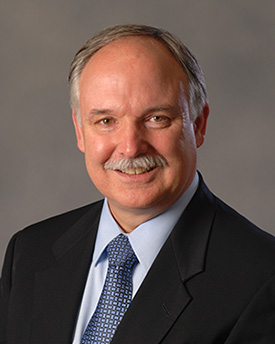Nov. 2, 2015:
A conversation with Patrick J. Loehrer, Sr., MD, director of the Indiana University Melvin and Bren Simon Cancer Center, which is a member of the Big Ten Cancer Research Consortium:
Q: How do you think cancer research will change in the next 10 or 20 years?
Cancer therapy, like much of medicine, is quite empiric. Understanding greater details of what drives tumors to grow will be greatly enhanced in the next several years. We are in the onset of the age of cancer informatics and immunotherapy. The information overload will need to be simplified into bite-size pieces of relevant information that can better identify the complex biological engineering of the cancer cell that nature has designed. Immunotherapy is already unleashing tremendous new opportunities, especially for highly mutated tumors from the therapeutic armamentarium. We have so much more to learn about the great potential and the limitations of this approach. These are truly exciting times.
Q: What does translational science look like within your institution and in your collaboration with other Big Ten CRC member institutions?
 Translational science is a “team sport.” We have position players in the basic, clinical, and population science fields, but it is the interactions between them that bring success. Our focus at Indiana University is to decrease the burden of cancer by addressing novel therapeutics and clarifying the somatic and germ line differences that can identify more precisely the therapeutic options based on the tumor and the host.
Translational science is a “team sport.” We have position players in the basic, clinical, and population science fields, but it is the interactions between them that bring success. Our focus at Indiana University is to decrease the burden of cancer by addressing novel therapeutics and clarifying the somatic and germ line differences that can identify more precisely the therapeutic options based on the tumor and the host.
We have been working closely with a number of Big Ten institutions, including the Purdue University Center for Cancer Research, with shared cores, joint projects, community retreats, and an embedding program which links engineers and non-biology scientists with our fellows and junior faculty. Through the Hoosier Cancer Research Network, the Indiana University Melvin and Bren Simon Cancer Center has conducted numerous clinical trials with our colleagues through the Big Ten CRC.
Q: In what ways is your institution involved in expanding access to clinical trials throughout the communities you serve?
We were the founding institution for the Hoosier Cancer Research Network (formerly the Hoosier Oncology Group), which links community physicians as active co-PIs of cancer studies. We have also expanded the National Cooperative Group Trials at selected sites within Indiana.
Q: How is the Big Ten CRC unique from other research consortia in which you participate?
 The Big Ten CRC is unique in that it focuses on cancer centers predominantly in the Midwest and has the support of its directors from the top down. The NCI has established criteria for transdisciplinary collaboration and now recognizes the importance of inter-institution collaboration. These are, typically, seen with one investigator collaborating with another. The uniqueness of the Big Ten CRC is that institutions, not just investigators, are collaborating together for a common cause. The tie with the athletic conference embodies the notion that our institutions may compete against each other on the athletic field, but in this fight against cancer, we are all on the same team.
The Big Ten CRC is unique in that it focuses on cancer centers predominantly in the Midwest and has the support of its directors from the top down. The NCI has established criteria for transdisciplinary collaboration and now recognizes the importance of inter-institution collaboration. These are, typically, seen with one investigator collaborating with another. The uniqueness of the Big Ten CRC is that institutions, not just investigators, are collaborating together for a common cause. The tie with the athletic conference embodies the notion that our institutions may compete against each other on the athletic field, but in this fight against cancer, we are all on the same team.
About the Big Ten Cancer Research Consortium: The Big Ten Cancer Research Consortium creates a unique team-research culture to drive science rapidly from ideas to treatment-changing paradigms. Within this innovative environment, today’s research leaders collaborate with and mentor the research leaders of tomorrow with the unified goal of improving the lives of all patients with cancer.
About the Big Ten Conference: The Big Ten Conference is an association of world-class universities whose member institutions share a common mission of research, graduate, professional and undergraduate teaching and public service. Founded in 1896, the Big Ten has sustained a comprehensive set of shared practices and policies that enforce the priority of academics in the lives of students competing in intercollegiate athletics and emphasize the values of integrity, fairness and competitiveness. The broad-based programs of the 14 Big Ten institutions will provide over $200 million in direct financial support to almost 9,500 students for more than 11,000 participation opportunities on 350 teams in 42 different sports. The Big Ten sponsors 28 official conference sports, 14 for men and 14 for women, including the addition of men’s ice hockey and men’s and women’s lacrosse since 2013. For more information, visit www.bigten.org.















Subscribe to the Big Ten CRC Newsletter X
X Facebook
Facebook YouTube
YouTube